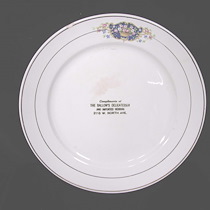Bedlam with Corned Beef on the Side Part VII
Written by Barry Kessler. Originally published in Generations 1993, reprinted in Generations 2011 – 2012: Jewish Foodways.
Part VII: Sandwich Innovation

Nates and Leon’s advertising card for the #3 sandwich. JMM 1992.053.003.
The variety of combination sandwiches offered by Sussman and Lev, not untypical of delicatessen fare of the 1920s, represented the innovations of a generation of immigrant sandwich-makers. As H.L. Mencken put it, “the Jewish mind was too restless and enterprising to be content with the old repertoire. It reached out for the novel, the dramatic, the unprecedented as it does in all the arts…It boldly struck out in the highest fields of fancy, and presently the lowly sandwich had been completely transformed and exalted.”[1] Besides raw materials from the Eastern European larder, delicatessens drew upon a vast variety of new American foodstuffs, with little regard for kashrut. By experimentation and evolution a host of new sandwiches entered American cuisine through the delicatessen. Many of these innovations came from New York, with its vibrant Jewish culture, and spread rapidly to other cities, including Baltimore. Others were invented here, two of the most notable by Nathan Ballow.
Nathan Ballow’s two claims to fame were the Easterwood Special – a half loaf of rye bread filled with bologna and a little mustard, named after the nearby park where the neighborhood boys played ball – and the hotdog and bologna combination. During the Depression many families made dinner out of the Easterwood Special, which sold for ten cents. Many remembered Ballow giving an Easterwood Special to beggars, always with the reminder that the recipient owed ten cents for it, to ease the shame of accepting charity.
Nathan Ballow’s hotdog and bologna combination entered the world of the Baltimore delicatessen by the mid-1930s. Joe Mandell, Ballow’s son-in-law, remembered how it happened: in the morning the countermen would cut off a few slices of bologna to make it look fresh, and once someone threw some of the slices on the griddle with some hotdogs and tried the combination.[2] It was an enormous success, copied by every delicatessen in the city and remembered by most of their patrons. It remains a deli staple to this day.

China plate from Ballow’s Delicatessen. JMM 1987.131.005
Nathan Ballow was an immigrant from Kiev who had worked as a cutter and tailor in East Baltimore for a few years after arriving in American around 1919. Known as a real “go-getter,” he opened a storke (little grocery) around 1925 at 2115 West North Avenue, in an area to which Eastern European Jewish families were beginning to move in considerable numbers. By the late 1920s his grocery had become a restaurant where neighborhood people enjoyed delicatessen without going downtown. It had become one of the focal points of the community.
Ballow’s attracted an almost exclusively Jewish clientele, advertising only on a Sunday afternoon radio program called Der Yidishe Radio Shtunde. The “noise, shouting, and tumult was wonderful to behold,” with at least half the people speaking Yiddish, remembered Ballow’s nephew years later.[3] It was a “creative Jewish atmosphere.”
Contributing to the ambiance were the smells of barrels of schmaltz herring, spices from the vats of meats cooking in the basement, and hotdogs and bologna on the grill. Herring was such a big seller that Ballow erected a huge sign reading “Headquarters for Good Luck Herring.” The busiest day was Saturday, despite the objections of several synagogues nearby. Nathan and his wife Sophie belonged to Har Zion, the largest Orthodox synagogue uptown, and kept kosher themselves. At some point during the 1930s, however, a mashgiach (kosher official) detected a problem with the kashrut of the food served, and following an embarrassing announcement in shul (synagogue), Ballow had to admit his place was not strictly kosher, but “kosher-style.”[4]

Mandell’s Delicatessen. JMM 1998.016.013.
In 1956, with the Jewish community moving further northwest, Ballow went into partnership with his son-in-law Joe Mandell, far uptown in a shopping center at Reisterstown Road and Rogers Avenue. Mandell, son of an immigrant from Kovno, had left Polytechnic High School around 1928 at age seventeen to make sandwiches at Boris Katz’s well-known deli on East Baltimore Street.[5] When Katz sold his deli to Mandell, he teamed up with Morris Scherlis to buy out Nathan Davis’s smokehouse, and Scherlis and Katz supplied Baltimore delicatessens with most of their smoked fish for several decades. In 1940 Mandell opened a deli in the downtown business district, open 24 hours a day, which he described as a modern restaurant, delicatessen, and fountain.[6] His step-mother, Jenny Wohlberg, did all the cooking, and her roast brisket, soups, and kokletten (small meat loaves) attracted “crowds greater than we had hoped, greater than our initial facilities could satisfy.”[7]
Continue to Part VIII: The “Madhouse” Lunch Trade
Notes:
[1] Baltimore Evening Sun, November 4, 1929.
[2] Interview with Joe Mandell (December 1992).
[3] Interview with Danny Ballow (October 1992).
[4] Interview with Shirley Ballow Rutkowitz (August 1992).
[5] Located at 1430 East Baltimore Street, it had been owned since about 1919 by Katz, a 1909 immigrant from Piesk, Poland.
[6] Baltimore Jewish Times, January 19, 1940, p. 9.
[7] Advertisement, January 19, unknown periodical. Jewish Museum of Maryland Vertical Files.
